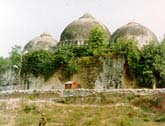The representation of a privileged Muslim community was woven
around a palpably false theory of Muslim appeasement
 Most of the points listed have been convincingly refuted, but
some carry conviction. This would not have been so if, instead
of making petty concessions to religious fears and sensibilities,
the secular establishment had conceived and implemented literacy
and poverty alleviation programmes for the poor and impoverished
Muslims.
Most of the points listed have been convincingly refuted, but
some carry conviction. This would not have been so if, instead
of making petty concessions to religious fears and sensibilities,
the secular establishment had conceived and implemented literacy
and poverty alleviation programmes for the poor and impoverished
Muslims.
It was all very well to push through a retrograde piece
of legislation in the Shah Bano case or to rush into banning The
Satanic Verses but such 'gestures of goodwill', usually timed
to coincide with state or parliamentary elections, proved prejudicial
to most Muslims.
Religious concessions per se, far from making
them feel secure or improving their material condition, reinforced
the stranglehold of orthodox and conservative clerics. They have
also provided the Hindu parties with a stick to beat the Congress
with, allowing them to expose the hollowness of a secular polity
that rested on pandering to Muslim religious sentiments, invent
areas of contestation between 'minority' and 'majority' interests,
conjure up the image of the Other, homogenise the segmented Hindu
population against the minorities, and create what Romila Thapar
has so aptly characterised as 'syndicated, semitised Hinduism.
The representation of a privileged Muslim community was woven
around a palpably false theory of Muslim appeasement, a theory
based on the works of Savarkar, Golwalkar and Hedgewar, high priests
of the Hindutva philosophy. But there were serious limits to what
such representations could achieved electorally. So the evocative
symbol of the Ram temple in Ayodhya was added to the BJP-RSS agenda.
The strategy worked from 1986 to 1992 because of the attachment
to Ram in the land of Aryavarta. It also worked because the Ayodhya
symbol is simultaneously provided both a rallying counter-ideology
against the divisiveness of caste and an all-embracing framework
capable of mobilising Hindus as an undifferentiated community.
 At the same time, the long-awaited miracle at the hustings did
not take place. L K Advani's chariot came to a standstill. A party
riding roughshod over the political process and claiming credit
for pulling down the Ayodhya mosque on December 6, 1992 suffered
major reverses in state and municipal elections.
At the same time, the long-awaited miracle at the hustings did
not take place. L K Advani's chariot came to a standstill. A party
riding roughshod over the political process and claiming credit
for pulling down the Ayodhya mosque on December 6, 1992 suffered
major reverses in state and municipal elections.
On 19-20 December 1964 the Indian Express carried two articles
describing the position of India's 55 million Muslims as 'sad'.
Its author A G Noorani commented on Urdu's plight on the Muslims
unequal treatment in employment, and on the threat to their physical
security. Add to this a near denial of even the rights to agitate
for redress, even to ventilate grievances, and you have the malaise
clearly spelt out.
Badruddin Tyabji, a retired diplomat, stressed
much the same themes four years later in three articles published
in The Statesman. So have others, with elaborate documentation.
The Gopal Singh Committee submitted its report to the central
government in June 1983. Radiance, the Delhi-based English weekly;
Muslim India, edited by Syed Shahabuddin; and Aijazuddin Ahmad's
studies reveal how most Muslims, chiefly in UP, Bihar, Madhya
Pradesh, Rajasthan and Bengal, remain on the lowest rung of the
ladder according to the basic indicators of socio-economic development.
The picture emerging from such writings is familiar. A large majority
of the Muslims -- nearly 71 per cent -- live in rural areas, and
are mostly landless labourers, small and marginal farmers, artisans,
craftsmen and shopkeepers. Their social stratification and class
interests are more or less the same as those of other people
in the countryside. More than half of the Muslim urban population
live below the poverty line, compared to about 35 per cent of
Hindus.
 Out of nearly 76 million, more than 35 million live below
the poverty line. The rest are self-employed. Many fewer urban
Muslims work for a regular wage or salary than members of other
religious groups. In most areas the Muslim share in
public and private employment is small.
Out of nearly 76 million, more than 35 million live below
the poverty line. The rest are self-employed. Many fewer urban
Muslims work for a regular wage or salary than members of other
religious groups. In most areas the Muslim share in
public and private employment is small.
In Kerala, Muslims had a comparatively higher literacy rate, yet
they were far behind others, sharing the endemic problem of their
co-religionist as a whole. The Mappilas, for example, held only
between a quarter and half of the percentage of positions in government
departments, proportionate to their share of the population.
Excerpted from Legacy of a Divided Nation, by Mushirul Hasan, 1997, Rs 495, with the publisher's permission.
|

